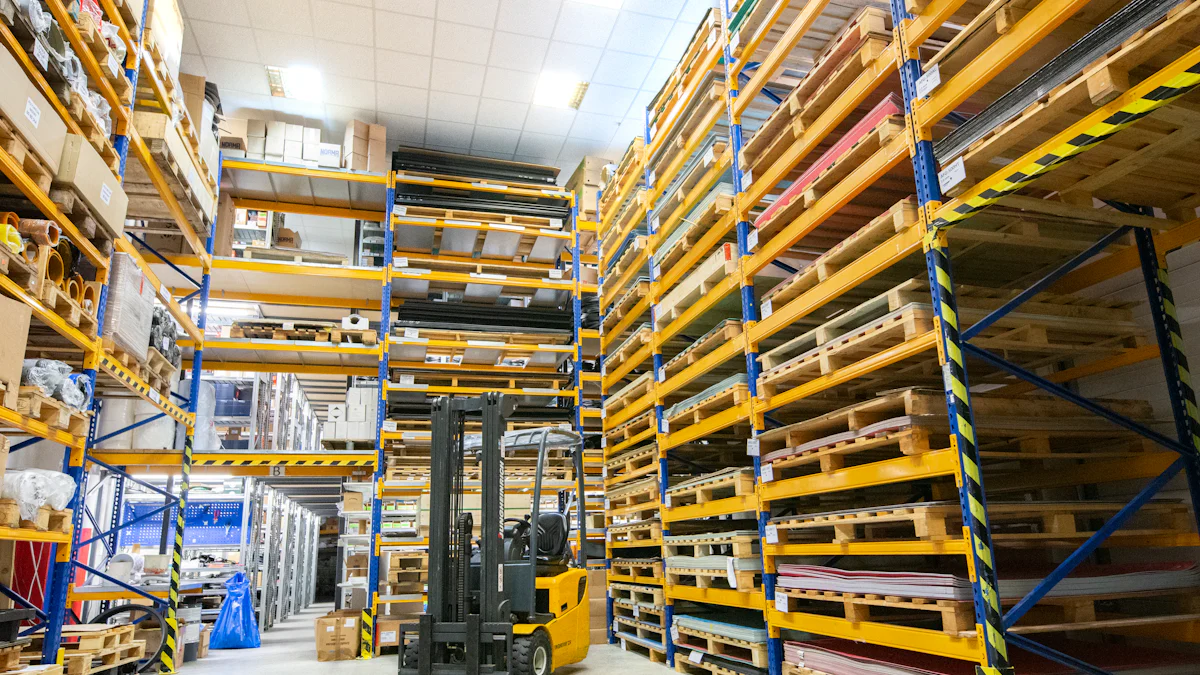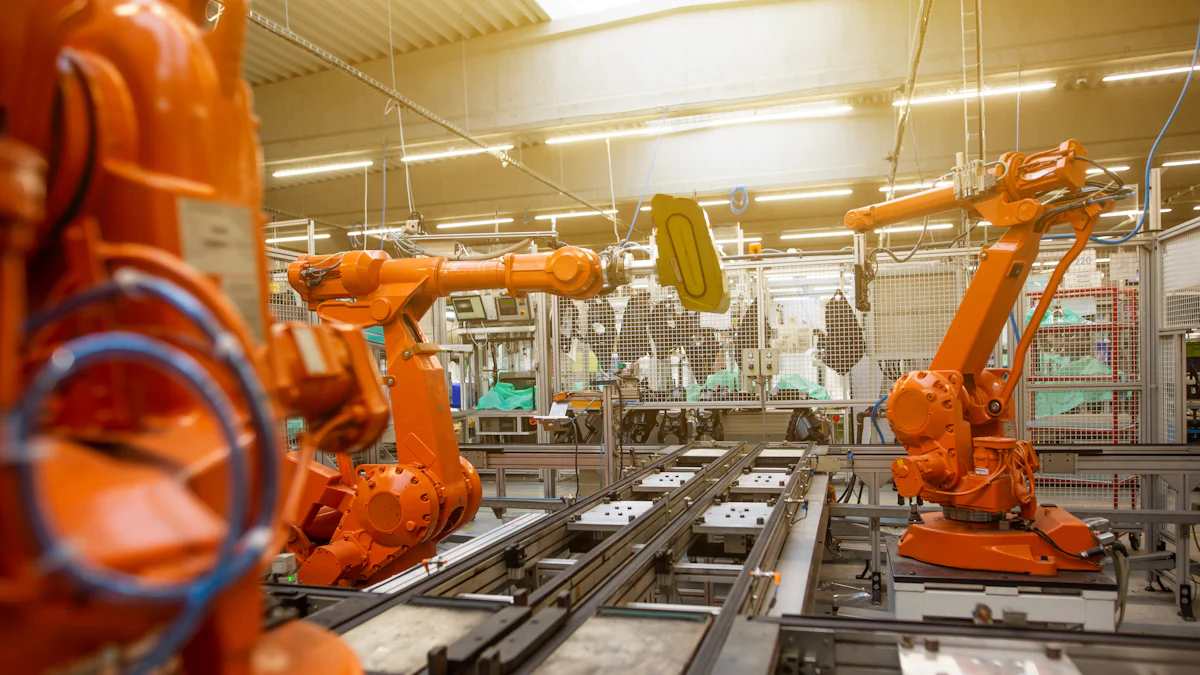Efficiency Boost: Robotic Automation in Warehousing Explained

In the realm of warehousing, efficiency stands as a pivotal pillar for success. The integration of robotic automation has revolutionized operations, propelling warehouses towards unparalleled productivity. Recent statistics reveal a significant surge in companies embracing this transformative technology, with a projected rise to 72% adoption within two years. The advent of autonomous mobile robots is reshaping supply chain dynamics, poised to exceed $27 billion in sales. Embracing robotic automation heralds a new era of streamlined processes and heightened performance. For more insights, check out our Blog on the Benefits of Robotic Automation in Warehousing.
Benefits of Robotic Automation

In the realm of warehousing, the integration of Robotic Automation brings forth a multitude of advantages that significantly enhance operational efficiency. Let's delve into the key benefits that propel warehouses towards unparalleled productivity.
Increased Efficiency
Faster Task Completion
Robots in warehousing excel at completing tasks swiftly and accurately, outpacing traditional manual methods. The implementation of robotic automation ensures that operations are executed with precision and speed, leading to a streamlined workflow.
Higher Throughput
With robotic automation at the helm, warehouses experience a substantial increase in throughput capacity. The seamless coordination between robots and systems results in optimized processes, allowing for a higher volume of tasks to be accomplished within the same timeframe.
Improved Accuracy
Error Reduction
One of the standout features of robotic automation is its impeccable accuracy in executing tasks. By minimizing human intervention and potential errors, robots ensure that each operation is carried out flawlessly, contributing to overall efficiency.
Consistent Performance
Robots exhibit unwavering consistency in their performance, eliminating variability often associated with human labor. Their ability to maintain a high level of accuracy and precision throughout repetitive tasks guarantees a reliable output that enhances operational effectiveness.
Cost Reduction
Lower Labor Costs
By leveraging robotic automation, warehouses can significantly reduce labor costs associated with manual work. The utilization of robots for various operations minimizes the need for extensive human workforce involvement, leading to substantial savings in labor expenses.
Reduced Operational Costs
In addition to lowering labor costs, robotic automation also contributes to reducing overall operational expenses. The efficient execution of tasks by robots optimizes resource utilization and minimizes wastage, ultimately driving down operational costs.
The evidence from Raben Group showcases how automation not only boosts sustainability but also delivers substantial cost savings amounting to €6 million annually. This success story underscores the transformative impact of automation on enhancing efficiency and performance within warehouse operations.
Operational Improvements
In the realm of warehousing, the integration of Robotic Automation not only enhances efficiency but also drives operational improvements that redefine the landscape of warehouse management. Let's explore how these enhancements pave the way for elevated productivity and safety standards while ensuring adaptability to dynamic market demands.
Enhanced Productivity
Automation of Repetitive Tasks
By automating repetitive tasks through robotic systems, warehouses can achieve a significant boost in productivity. The seamless integration of robots into daily operations streamlines processes, allowing for a more efficient workflow and optimized task completion.
Focus on Strategic Roles
With robots handling mundane and repetitive tasks, human workers can redirect their focus towards strategic roles within the warehouse. This shift enables employees to engage in higher-value activities that require critical thinking and decision-making, ultimately enhancing overall operational effectiveness.
Safety and Ergonomics
Reduction of Physical Strain
Robotic automation plays a pivotal role in reducing physical strain on warehouse workers by taking over strenuous and labor-intensive tasks. By delegating these responsibilities to robots, employees experience less physical fatigue, promoting better health and well-being in the workplace.
Improved Workplace Safety
The implementation of robotic systems contributes to improved workplace safety standards by minimizing the risk of accidents and injuries associated with manual labor. Robots are designed to operate with precision and caution, creating a safer environment for employees to carry out their duties without compromising their well-being.
Scalability and Flexibility
Adaptation to Demand Changes
One of the key advantages of robotic automation is its ability to adapt swiftly to fluctuations in demand within the warehouse. As market dynamics evolve, automated systems can scale operations up or down efficiently, ensuring that resources are allocated effectively based on current requirements.
Streamlined Operations
Through the integration of robotic solutions, warehouses can achieve streamlined operations that enhance overall efficiency. The synchronized efforts between robots and existing infrastructure lead to optimized processes, reduced bottlenecks, and improved resource utilization, resulting in a more agile and responsive operational framework.
The Blog on the Benefits of Robotic Automation in Warehousing sheds light on how these operational improvements are reshaping traditional warehouse practices. Embracing robotic automation not only propels warehouses towards enhanced productivity but also sets a new standard for safety compliance and operational flexibility.
Future Trends

Integration with AI
The integration of Artificial Intelligence (AI) into warehouse robotics heralds a new era of innovation and efficiency. By leveraging AI technologies, robots are now equipped with advanced capabilities that transcend traditional automation boundaries. The convergence of robotics and AI empowers machines to not only perform tasks but also comprehend and respond to human interactions, creating a more intuitive and adaptive environment within warehouses.
Predictive Analytics
Predictive analytics plays a pivotal role in enhancing operational foresight and decision-making processes. Through the utilization of AI algorithms, robots can analyze vast datasets to anticipate trends, identify patterns, and forecast future outcomes. This proactive approach enables warehouses to optimize resource allocation, streamline workflows, and preemptively address potential challenges.
Advanced Decision Making
The marriage of robotics with AI fosters advanced decision-making capabilities that elevate operational efficiency. By integrating cognitive computing systems, robots can process complex information in real-time, enabling them to make informed decisions autonomously. This strategic autonomy enhances responsiveness, agility, and adaptability within warehouse operations.
Expansion of Automation
The evolution of robotic automation transcends conventional boundaries as emerging technologies redefine the scope of automated solutions. With continuous advancements on the horizon, warehouses are poised to embrace a new wave of automation innovations that revolutionize industry standards.
New Technologies
New technologies in the realm of warehouse robotics open doors to unprecedented possibilities for enhanced performance and functionality. From collaborative robots (cobots) to machine learning algorithms, these cutting-edge tools augment the capabilities of robotic systems, paving the way for increased productivity and operational excellence.
Broader Applications
The proliferation of robotic automation extends beyond traditional warehouse functions to encompass a diverse range of applications across industries. As robots become more versatile and adaptable, their utility expands into areas such as autonomous vehicles, smart manufacturing systems, and personalized caregiving assistants. This diversification underscores the transformative impact of automation on reshaping societal norms and industrial landscapes.
The synergy between robotics and AI propels warehouses towards a future defined by innovation, efficiency, and adaptability. As these technologies continue to evolve in tandem, the possibilities for enhanced productivity and operational excellence are limitless.
Embracing robotic automation in warehousing yields a myriad of benefits, including increased efficiency, improved accuracy, and substantial cost reductions. The seamless integration of robots enhances productivity, streamlines operations, and ensures compliance with unparalleled precision. As industries evolve towards automated solutions, the future outlook for robotic technologies remains promising. Recommendations include continued investment in AI integration and embracing new automation technologies to drive operational excellence and adaptability in the ever-changing market landscape. Robotic automation is not just a trend; it's a transformative force shaping the future of warehousing efficiency and performance.
See Also
Insights into AI Integration: Unveiling the Future Supply Chain
Efficiency Redefined: Logistics Optimization by JUSDA
A Glimpse into the Future: Breakthroughs in Logistics Tech
Resolving Supply Chain Issues: Solutions for High-Tech Manufacturing
The Impact of Innovation: Revolutionizing Logistics in Supply Chain
